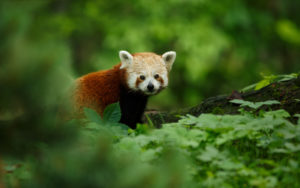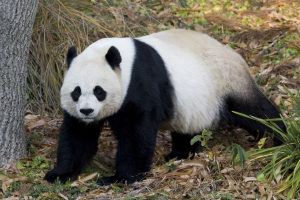The Strange Tale (And Tail) of the Red Panda
September 20, 2018 - 4 minutes read
The Indian subcontinent offers animal diversity that far exceeds the tiger, leopard, lion, elephant and rhino. One of the remarkable yet lesser-known animals you might come across on a Jungle Sutra safari is the cute little red panda (Ailurus fulgens).
With its “masked” raccoon-like face, foxy ears and long, bushy, striped tail — not to mention its distinctive reddish-brown fur — the red panda often vies for the title of “cutest creature” in the animal kingdom. And that doesn’t even get into how adorable the cute the cubs are.
The red panda only became known to Western science in 1821, when British naturalist Major General Thomas Hardwicke made a presentation to the Linnean Society in London entitled “Description of a new Genus of the Class Mammalia, from the Himalaya Chain of Hills Between Nepaul and the Snowy Mountains.”
Hardwicke strongly suggested that the newfound animal be called the “wha” — a name derived from the noise it makes.
However, his findings weren’t published until 1827. In the meantime, French zoologist Frédéric Cuvier had published his own description and a drawing of the Asian mammal. Naming rights, therefore, went to Cuvier. And he decided to call it a panda, most likely because its local name “Ponya” meant bamboo-eating animal.
By the late 19th century, scientists had noticed that the “parti-colored bear” (that’s  what the giant black-and-white panda was originally called) and red panda were very similar despite their tremendous difference in size. Among these similarities were their jaw structure, false thumbs, geographical location, and bamboo-heavy diet.
what the giant black-and-white panda was originally called) and red panda were very similar despite their tremendous difference in size. Among these similarities were their jaw structure, false thumbs, geographical location, and bamboo-heavy diet.
A decision was made to officially classify the little red panda as a type of bear. But during the early 20th century, that decision was reversed. Parti-coloured bears were declared bears, while red pandas were classified as cousins of the raccoon.
But that wasn’t the end of the scientific discord. A few years later it was decided that parti-coloured bears weren’t bears at all, but actually large pandas, as well as distant relatives of the raccoon.
Because they were no longer classified as bears, a name change was necessary and the roly-poly, black-and-white creatures became giant pandas, while its little cousin was renamed the red or lesser panda.
By the 1980s, genetic research discovered that giant pandas actually are a type of bear, and red pandas belonged in their own family, the Ailuridae. In fact, it’s the only living species of that family. So while the two types of panda might seem similar, they’re not related.
The red panda and giant panda share a high-altitude, forest habitat in China. But the geographical range of the red panda extends into the mountains of Nepal, eastern India, Bhutan and northern Myanmar.
Red pandas love to munch bamboo (only the young leaves), but they also eat fruit, roots and sometimes even eggs and insects, a diet which gives them the weird classification “vegetarian carnivore.”
However, the food they eat is so nutritionally poor they have to spend around 13 hours a day looking for or eating food and they can lose up to 15% of their body weight in the winter when food is scarcer.
Red pandas spend most of their lives in trees and even sleep aloft. When foraging, they are most active at night as well as dusk and dawn. They are shy and solitary, except when mating. Females give birth in the spring and summer, typically to one to four young.
Young red pandas remain in the nest for about 90 days, during which time their mother cares for them. Males take little or no interest in their offspring.
Tags: exotic India, indian safari, Jungles Sutra, lesser known animals, panda, red panda
0 Comments